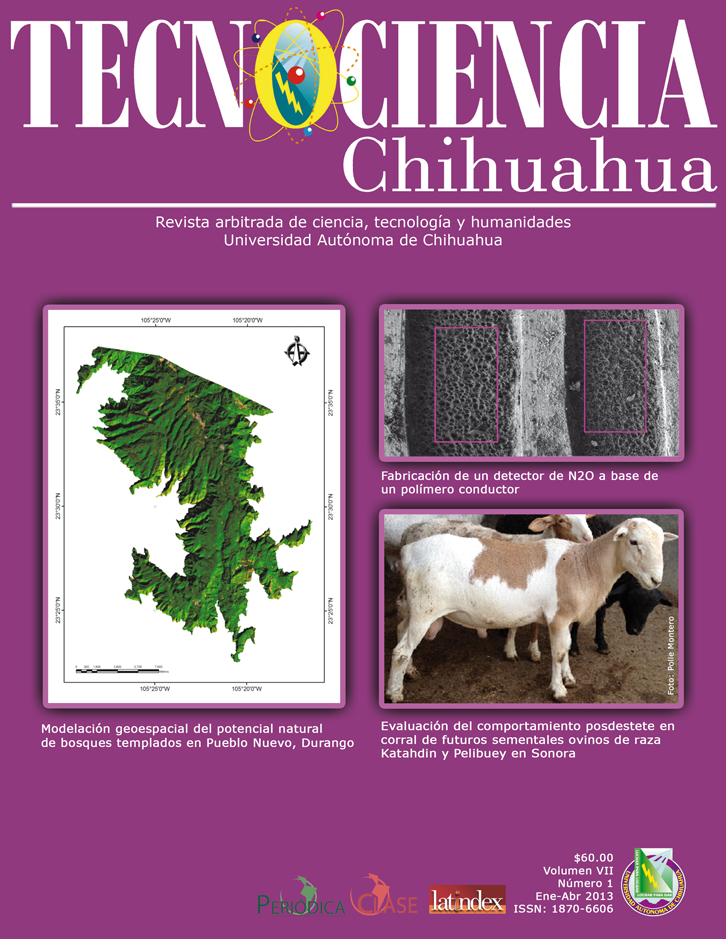Fabricación de un detector de N2O a base de un polímero conductor
Fabrication of a N2O detector based on a conductive polymer
Resumen
Recientes investigaciones demuestran la capacidad de la polianilina (PANI) para detectar la presencia de diferentes gases por medio de cambios en sus propiedades eléctricas; este método resulta de fácil diseño, síntesis directa y costos accesibles. El objetivo de esta investigación es demostrar la capacidad del polímero para detectar la presencia de gases contaminantes, en este caso el óxido nitroso debido al cambio de resistencia eléctrica del PANI. Esta metodología se basa en exponer el polímero a cierta concentración de gas y medir sus cambios eléctricos. Existen métodos tales como la Espectroscopía de Impedancia Electroquímica (EIS por sus siglas en inglés) que permiten medir dichas alteraciones. Se utilizó un dispositivo de cobre recubierto con sal de PANI y expuesto a 100% de concentración de N2O conectado a un equipo Solatron Interfase modelo Electroquimic 1287. Se utilizó el software Z- view para interpretar los cambios eléctricos producidos en el material por medio de gráficos de Nyquist. Al conocer la estructura química del PANI y la del N2O se supuso cómo se lleva a cabo el desplazamiento de un átomo de hidrógeno, para posteriormente ser ocupado por el sitio vacante por el nitrógeno y entonces modificar temporalmente la cadena polimérica y, como consecuencia, alterar las propiedades conductoras del polímero. El efecto se produce únicamente en la superficie de la película, por ello, el enlace puede disociarse al elevar la temperatura del sistema de 40 a 60 °C y entonces utilizar nuevamente el PANI para una siguiente prueba.
Abstract
Recent investigations demonstrate the ability of polyaniline (PANI) for detecting the presence of different gases through changes in electrical properties, this method is easy to design, direct synthesis and affordable costs. The objective of this study is to demonstrate the ability of the polymer to detect the presence of gaseous pollutants, in this case the nitrous oxide due to the change of electrical resistance of PANI. This methodology is based on exposing the polymer to a certain concentration of gas and measure electrical changes. There are methods such as electrochemical impedance spectroscopy (EIS for its acronym in English) that measure these changes. It was used a copper device coated with salt PANI and exposed to 100% concentration of N2O connected to a computer interface Solatron Electroquimic model 1287. We used the Z-view software to interpret the electrical changes produced in the material by means of Nyquist plots. By knowing the chemical structure of PANI and N2O the mechanism of displacement of a hydrogen atom was assumed to be subsequently occupied by nitrogen, leading to a temporal modification of the polymeric chain which alters the conductive properties of the polymer. The effect occurs only on the surface of the film, therefore, the link can be dissociated by raising the system temperature from 40 °C to 60 °C and then used PANI again for the next test.
Keywords: detector, electrochemical impedance spectroscopy (EIS), nitrous oxide (N2O), conductive polymer.
Citas
Agbor, N.E., M.C. Petty & A.P. Monkman. 1995. Polyaniline thin-films for gas-sensing. Sensors and Actuators B: Chemical 28(3):173-179. https://doi.org/10.1016/0925-4005(95)01725-9
Abdellah, A., B. Fabel, P. Lugli & G. Scarpa. 2010. Spray deposition of organic semiconducting thin-films: towards the fabrication of arbitrary shaped organic electronic devices. Organic Electronics 11(6):1031-1038. https://doi.org/10.1016/j.orgel.2010.02.018
Anderson, I.C. & J.S. Levine. 1986. Relative rates of nitric oxide and nitrous oxide production by nitrifiers, desnitrifiers, and nitrate respires. Applied and Environmental Microbiology 51(5):938-945. https://doi.org/10.1128/aem.51.5.938-945.1986
Bond, M., S. Fletcher, F. Marken, S.J. Shaw & P.G. Symons. 1996. Electrochemical and X-ray diffraction study of the redox cycling of nanocrystals of 7, 7, 8, 8-tetracyanoquinodimethane. Observation of a solid-solid phase transformation controlled by nucleation and growth. Journal of the Chemical Society, Faraday Transactions 92(20):3925-3933. http://doi.org/10.1039/FT9969203925
Elizalde-Torres, J., H. Hu & J.M. Saniger. 2005. Comparison of NO2 and NH3 gas adsorption on semiconductor polyaniline thin films. Revista Mexicana de Física 51(5). https://www.scielo.org.mx/scielo.php?script=sci_arttext&pid=S0035-001X2005000500007
Freund, M. S., A. Brajter-Toth, M. D. Ward, 1990. Electrochemical and Quartz crystal microbalance evidence for mediation and direct electrochemical reactions in small molecules at Tetrathiafulvalene-te. Journal of Electroanalytical Chemistry and Interfacial Electrochemistry 289(1-2):127-141. https://doi.org/10.1016/0022-0728(90)87211-2
Hayon, E. & J.J. McGarvey. 1967. Flash photolysis in the vacuum ultraviolet region of SO42−, CO32 and OH− ions in aqueous solutions. The Journal of Physical Chemistry 71(5):1472–1477. https://doi.org/10.1021/j100864a044
Janata, J., M. Josowicz, P. Vanysek & D.M. DeVaney. 1998. Chemical Sensors. Analytical Chemistry 70(12):179-208. https://doi.org/10.1021/a1980010w
Kasapoglu, F., A. Onen, N. Bicak, Y. Yagci. 2002. Photoinitiated cationic polymerization using a novel phenacyl anilinium salt. Polymer 43(8):2575-2579 https://doi.org/10.1016/S0032-3861(02)00029-0
Natta, G. & G. Mazzanti. 1960. Organometallic complexes as catalyst in ionic polymerizations. Tetrahedron 8(1-2):86-100. https://doi.org/10.1016/S0040-4020(01)93335-6
Palaniappan S. & C. A. Amarnath. 2006. A novel polyaniline–maleicacid–dodecylhydrogensulfate salt: Soluble polyaniline powder. Reactive and Functional Polymers 66(12):1741–1748. https://doi.org/10.1016/j.reactfunctpolym.2006.08.002
Rickerby, D.G. & M. Morrison. 2006. Nanotechnology and the environment: A European perspective. Science and Technology of Advanced Materials 8(1-2):19-24. https://doi.org/10.1016/j.stam.2006.10.002
Toi, K., H. Takai, T. Shirakawa, T. Ito & I. Ikemoto. 1989. Analysis of the permeation of CO2 through glassy polymers. Journal of Membrane Science 41(15):37-47. https://doi.org/10.1016/S0376-7388(00)82389-3
Yan, X.B. Z.J. Han, Y. Yang & B.K. Tay. 2006. NO2 gas sensing with polyaniline nanofibers synthesized by a facile aqueous/organic interfacial polymerization. Sensors and Actuators B: Chemical 123(1):107-113. https://doi.org/10.1016/j.snb.2006.07.031
Derechos de autor 2020 TECNOCIENCIA Chihuahua

Esta obra está bajo licencia internacional Creative Commons Reconocimiento-NoComercial 4.0.









